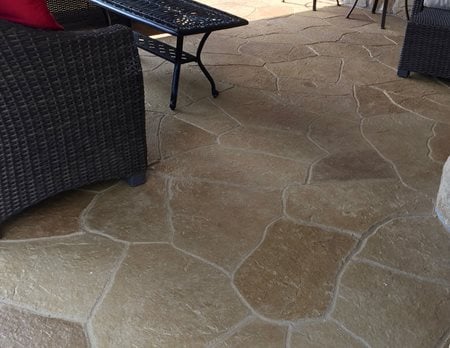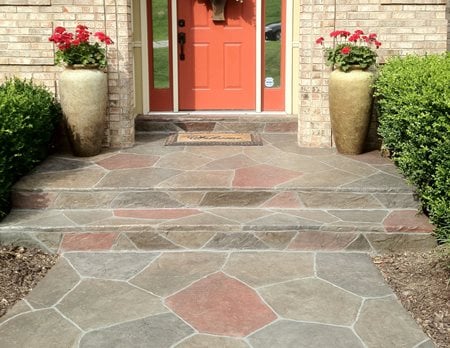Is Stamped Concrete Slippery? 4 Anti-Slip Solutions
Stamped concrete provides the ability to get the look of just about any type of material such as brick, wood, tile, limestone, and more. The options are endless. But what about the safety of stamped concrete? Here, we’ll discuss what you need to know to make sure your stamped concrete surface isn’t a slip-and-fall hazard.
 This stamped concrete surface by SUNDEK of Nashville is textured, providing grip for wet bare feet.
This stamped concrete surface by SUNDEK of Nashville is textured, providing grip for wet bare feet. Stamped concrete has texture on the surface which helps create a anti-slip profile. But when stamped concrete is sealed it can become slippery, especially when wet. Read on for ways to avoid slippery stamped concrete.
1. Use a pattern with a heavy texture
The size and height of the texture can affect the degree of slip resistance: low and flat texture is less slip resistant than a taller texture. Ensuring that your concrete is stamped at the correct time after the concrete is poured will also help achieve full texture.
2. Choose your sealer carefully
Glossy, film-forming sealers can create a slick surface. Instead, use a penetrating sealer that soaks into the concrete. They’re an excellent choice if you’re seeking the look of natural stone.
 ATD Concrete Coatings used SunStamp to create this textured patio area.
ATD Concrete Coatings used SunStamp to create this textured patio area. 3. Apply sealer in thin coats
Even a stamped surface can be slippery if a sealer is applied incorrectly. A thick coating of sealer can make a surface slippery, so it’s important to apply the appropriate amount. (In addition to creating a slippery surface, a thick coat of sealer can also create a whitish film on the surface of your concrete.)
4. Use a slip-resistant additive
If you love the glossy look of acrylic sealers, include additives to make the coating of sealer slip resistant. These work by adding a little extra grip to your stamped concrete. If your surface profile doesn’t have adequate texture, it’s critical that your contractor include aggregates in your sealer.
For residential and light commercial applications use synthetic materials such as polypropylene beads or “Shark Grip” type materials. For commercial, heavy traffic areas, or steep slope situations, use hard mineral materials such as aluminum oxide or silica sand.
Keep in mind that smaller particle sizes spaced closer together achieve really good traction, but the almost sandpaper-like finish makes the surface somewhat difficult to clean. Larger, particle sizes spaced farther apart provide acceptable traction and are easier to clean. The trick is to find the right balance between size and distribution.
 For this walkway leading up to a residential home, Decorative Concrete Resurfacing of St. Louis, MO, used SunStamp to create a beautiful walkway with a slip-resistant surface.
For this walkway leading up to a residential home, Decorative Concrete Resurfacing of St. Louis, MO, used SunStamp to create a beautiful walkway with a slip-resistant surface.Ways SUNDEK can help
If you already have stamped concrete that doesn’t have good traction, we can come reseal it using additives. If you’re considering a new stamped pool deck, patio or driveway, don’t worry we’ll ensure it isn’t slippery by employing both texture and good sealing practices.
Need help figuring out what’s right for your surface? Contact us! We’ll look at your project, discuss your best options, and give you a free quote.
Are there other decorative systems for slip resistance?
SUNDEK’s Classic Texture system is known in the industry for having an ideal effect to reduce the slipperiness of a surface.
In fact, it’s so effective that its most common use is around swimming pools and other wet environments where slip resistance is important.
Although Classic Texture doesn’t necessarily need a finish coat with slip-resistant additives, clients often request them for added peace of mind.
Find a local contractor to help with your slip-resistant surface
SUNDEK has local contractors all across the country ready to help with your project. Find a contractor near you.